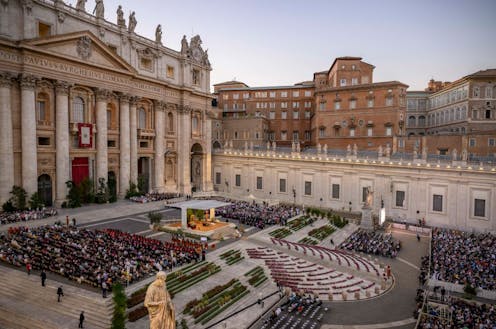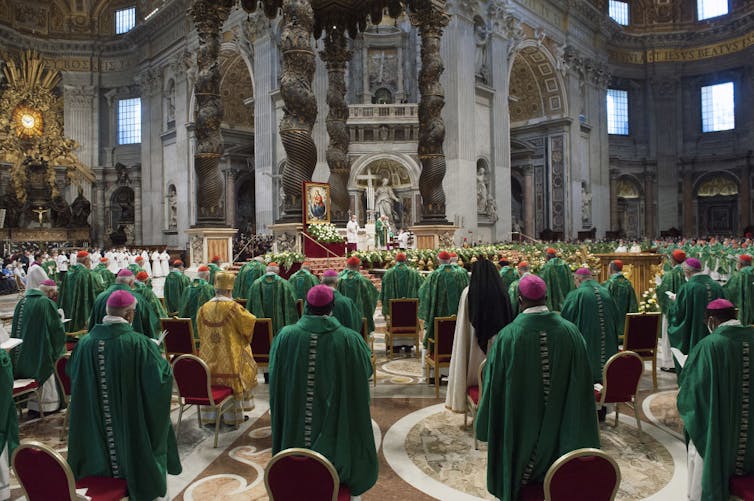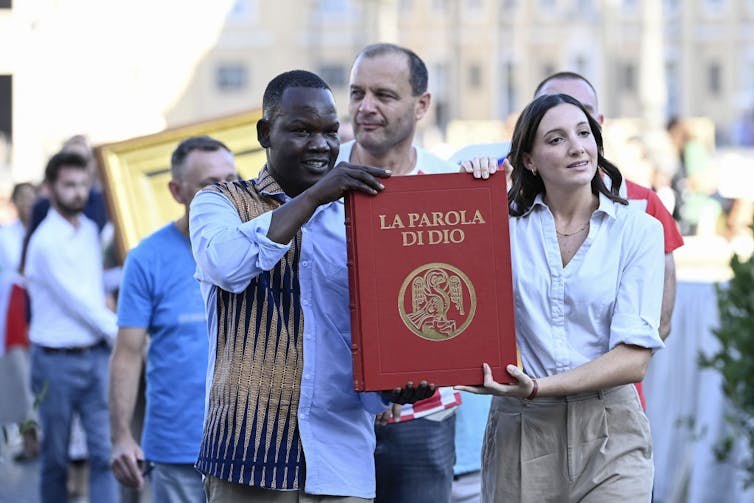
The 16th Synod of Bishops, the first part of which will take place in Rome on Oct. 4-29, 2023, and the second in 2024, will be the culmination of a two-year, worldwide conversation in the Catholic Church.
The term “synod” usually refers to a local or regional meeting of church leaders. The Synod of Bishops was established by Pope Paul VI in 1965 as a permanent body in the Catholic Church, although its members do not meet on a regular schedule. It specifically refers to a meeting of selected bishops from around the world to advise the pope on matters of governance.
The Synod of Bishops was set up after the Second Vatican Council, which was held from 1962 to 1965, to bring reforms and updates to the church. The Second Vatican Council stated that the entire college of all Catholic bishops, under the authority of the pope, also serve as the church’s highest authority. Paul VI instituted the Synod of Bishops as a way for Catholic bishops to exercise this authority. The council also stated that lay Catholics have an active role to play in the church.
As a theologian who studies the Catholic Church, with an emphasis on the period during and after Vatican II, I argue that this upcoming synod reflects Pope Francis’ efforts to advance the reform agenda of Vatican II. He wants all Catholics to take an active role in thinking about the future of their church and wants the bishops to exercise their authority by first listening to the people.
A more open church?
Typically, there are three types of meetings of the Synod of Bishops.
Ordinary general assemblies usually get together every three or four years. The pope can also call an extraordinary meeting to discuss a more pressing topic and problem. Finally, popes have called special meetings of bishops in a certain region. For example, Francis held a special Synod on the Amazon in 2019.
The 16th Synod of Bishops is an ordinary general assembly. At the direction of Francis, its preparation, initiated at a celebration in Rome in 2021, involved a worldwide conversation among Catholics about their church.
Catholics from around the world were invited to meet in their local dioceses, pray together and discuss questions about their church. Some 700,000 Catholics across the U.S. took part in these conversations.
The local churches collected and summarized the results of these meetings. Leaders at the regional, national and, finally, continental levels drafted reports on these conversations.
On the basis of all these earlier documents, in May 2023 the Vatican released its working document called “Instrumentum Laboris” for the upcoming synod.
This meeting is therefore significant because it pictures the Catholic Church not as a top-down hierarchy but rather as an open conversation. For the first time, its voting members will not only be bishops but other Catholics as well. The changes indicate Francis’ intention to give all Catholics a voice in the decision-making process of the church.
As Francis himself puts it, the synod offers an opportunity “of moving not occasionally but structurally towards a synodal church, an open square where all can feel at home and participate.”
Working document
Some 450 people are expected to be in Rome for the first part of the synod. This number will include representatives of religious orders and other Catholic organizations, as well as theologians from Catholic universities.
The pope’s expanded list will include a number of lay men and women. Additionally, representatives from other Christian churches will also attend the synod – although they will not have voting rights.
Those gathered in Rome will meet in both large sessions known as “general congregations” and small working groups, divided by the synod’s official languages – Italian, English, Spanish, French and Portuguese. Its official documents will be issued in Italian and English.

The working document outlines four broad areas of discussion: synodality, communion, mission and participation. The first term refers to the idea that the church as a whole should incorporate the synod’s process of focused conversations, listening and dialogue into its structure. The next two – communion and mission – refer to how a global church can balance unity and diversity in pursuit of its aims. The final term, participation, refers to the ways in which Catholics, both clergy and lay people, can take part in the church. This topic also includes discussion about what institutions and structures the church would need to create to serve its mission.
When participants talk about these topics, they will discuss issues that have divided the church, such as the inclusion of LGBTQ+ people, the role of women in the church, relations between the Catholic Church and other churches, and relations between the church and different cultures, among others.
Francis’ leadership style
This Synod of Bishops reflects Francis’ style of leadership and his vision of the Catholic Church for the future. In his address to the synod held on Oct. 9, 2021, the pope said the success of the mission of the church depends on the closeness of the church to its people and their ability to listen to one another.

The internal enemy of the mission of the church, according to Francis, is “clericalism,” the idea that clergy – priests and bishops – are somehow a spiritually superior class, separate from and above regular lay people. Francis himself has modeled a different version of the papal office by rejecting many customs that he associates with clericalism. For example, he has continued to live in a modest apartment rather than in the Vatican palace.
Through the process of consultation and conversation, Francis intends to combat clericalism in the Catholic Church by offering a different model for how the church can work. As Austen Ivereigh, a British journalist and biographer of Francis, has written: “The opposite of clericalism [for Francis] is synodality, meaning a method and process of discussion and participation in which the whole people of God can listen to the Holy Spirit and take part in the life and mission of the Church.”
After an additional year of conversations with the wider church, participants will gather in Rome again in 2024, when they will continue the discussions and vote on recommendations to the bishops. The bishops will in turn make recommendations to the pope, who will have the final say.
If Francis’ model of the church is persuasive, this synod, I believe, will be the beginning of an ongoing process in the church, the first of many conversations to come.
Daniel Speed Thompson does not work for, consult, own shares in or receive funding from any company or organisation that would benefit from this article, and has disclosed no relevant affiliations beyond their academic appointment.
This article was originally published on The Conversation. Read the original article.







